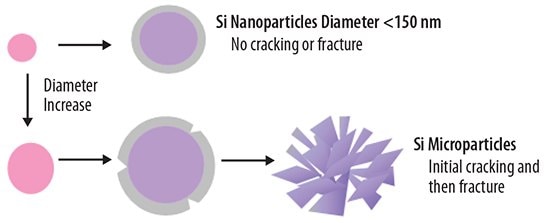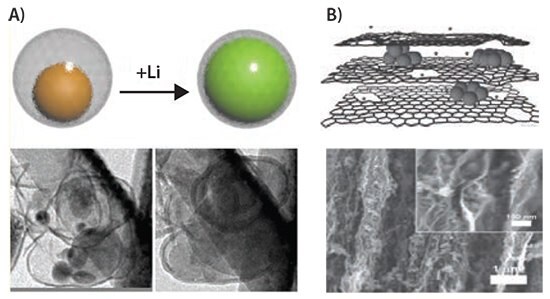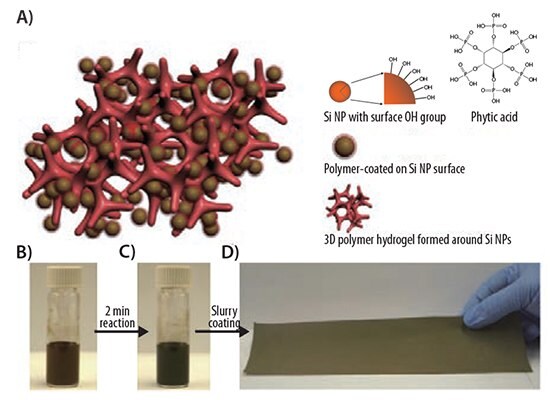Recent Developments in Silicon Anode Materials for High Performance Lithium-Ion Batteries
Xuefeng Song1, Xiaobing Wang2, Zhuang Sun1, Zhuang Sun1, Peng Zhang1, Lian Gao1
1State Key Laboratory for Metallic Matrix Composite Materials, School of Materials Science and Engineering, Shanghai Jiao Tong University, Shanghai, 200240, China, 2Baoshan Iron & Steel Co., Ltd. Tube, Pipe and Bar Business, Baoshan District, Shanghai, 201900, China
Introduction
Recent demand for electric and hybrid vehicles, coupled with a reduction in prices, has caused lithium-ion batteries (LIBs) to become an increasingly popular form of rechargeable battery technology. According to a new IHS Isuppli Rechargeable Batteries Special Report 2011, global lithium-ion battery revenue is expected to expand to $53.7 billion in 2020, up from $11.8 billion in 2010.1 However, graphite (Prod. Nos. 496596, 636398, and 698830), the traditional anode material in lithium-ion batteries, does not meet the high energy demands of the advanced electric and hybrid automobile market due to its limited theoretical specific capacity of ~370 mAh g−1.2 This has led to the proposal of a large number of anode materials with enhanced storage capacity, high energy density, and improved cycle characteristics for lithium-ion batteries over the last decade.3-7 Table 1 summarizes the properties of several different anode materials. Among these advanced anode materials, Si has attracted substantial attention as an alternative for Li-ion batteries, primarily due to 1) its specific capacity of 4,200 mAhg-1 and volume capacity of 9,786 mAh cm-3, the highest known for a LIB anode; 2) relatively low working potential (0.5 V vs. Li/Li+); and 3) the natural abundance of element Si and its environmental benignity.8-10
However, the practical implementation of Si anodes is still blocked due to three major problems. First, poor cycle-life of silicon materials results from pulverization during the huge volumetric fluctuations (>300 %) which accompany lithium ion intercalation and deintercalation. Second, drastic irreversible capacity loss and low coulombic efficiency is caused by mechanical fracture of Si anodes during the alloying/dealloying process. Finally, the solid electrolyte interphase (SEI) breaks as the nanostructure shrinks during delithiation. This results in the exposure of the fresh silicon surface to the electrolyte and the reformation of the SEI, resulting in the SEI growing thicker with each charge/discharge cycle, as shown in Figure 1.11, 12

Figure1. Schematic of SEI formation on a pure silicon surface during charge/discharge cycles.
Nanostructured Silicon Anode Materials
To address these issues, several strategies have been developed to accommodate the huge volumetric changes. One effective strategy is to reduce the active particle size to the nanometer range, at which point, nanosized particles can accommodate significant stress without cracking, as well as decreasing the electronic and ionic transport distance. Moreover, the high density of grain boundaries in nanomaterials also provides a fast diffusion path for Li ions and acts as additional Li-storage sites.13-16 Huang et al. have shown the effect of Si nanoparticle size on the release of structural stress by in situ transmission electron microscopy (TEM) and suggested the stored strain energy from electrochemical reactions was insufficient to drive crack propagation in Si nanoparticles if the particle diameter is <150 nm (Figure 2).17 Recently, Kim et al. reported 5, 10, and 20 nm-sized Si nanoparticles can be synthesized under high pressure at 380 °C by using various surfactants.18 Cycling these materials between 0 and 1.5 V at a rate of 0.2 C, a capacity of 2,500 mAh g-1 can be achieved for over 40 charge/discharge cycles with capacity retentions of 71, 81, and 67%, respectively.

Figure 2. Schematic of the stability of silicon during cycles influenced by the diameter size.
Kim et al. also reported an intriguing 3D bulk Si architecture with a highly interconnected porous structure.19 With 40-nm thick pore-walls, this Si structure can accommodate large strains without pulverization, even after 100 cycles, and maintained a charge capacity of greater than 2,800 mA h g-1 at a rate of 1 C (2,000 mAg‑1). The Cui group at Stanford University reported silicon nanowire and nanotube anodes show high discharge capacities and stability over tens of cycles, with reversible capacities as high as ~3,200 mAhg-1 (for nanowires) and ~3,247 mAhg-1 (for nanotubes).20,21 Nanowire- and nanotube-based electrodes can accommodate material expansion during cycling, as well as forming a direct current pathway when grown directly onto the current collector.10 In addition, Si nanotubes increase the surface area accessible to the electrolyte, by allowing Li ions to intercalate at the interior and exterior of the nanotubes.
Despite the advantages of nanostructured Si anodes, nanosized particles also have disadvantages, such as large surface area, high manufacturing costs, and difficulty of handling.22 Even so, nanostructured silicon is regarded as one of the most promising methods to overcome the challenges of silicon anodes for the next generation lithium-ion batteries.
Si-based Carbon Composite Anode Materials
Another approach to overcome the volume change during cycling is to form a composite material.23 The matrix does not experience significant volumetric change, which may buffer the expansion of silicon, maintain the structural integrity of the electrode, and enhance stability by reducing silicon aggregation or electrochemical sintering.10
One promising research area is silicon-based carbon composites, the benefits of which are attributed to the improved electric conductivity and the expansion buffering effect of a carbon matrix.24-27 In addition, the carbon additives have the advantages of exceptional ionic conductivity and Li- storage ability.28,29 However, a conformal carbon coating on Si active material would rupture during cycling, resulting in Si exposure to electrolytes and additional SEI deposition. Therefore, a form of carbon coating that can accommodate the large volume fluctuation of Si is necessary.

Figure 3. Schematic of yolk–shell structured Si hybrid in which the internal void space can accommodate Si volume expansion during lithiation, protecting the surface of the Si core from SEI deposition.
One effective approach is the introduction of abundant void space between Si and the carbon shell, as shown in Figure 3.30 Liu et al. reported a yolk–shell structured Si@Carbon (Figure 4A) with excellent capacity (2,833 mAhg-1 at C/10), cycle-life (1,000 cycles with 74% capacity retention), and coulumbic efficiency (99.84%).31 Si nanoparticles were first coated with a SiO2 layer and then with a polydopamine layer, which was subsequently carbonized to form a nitrogen-doped carbon coating, the yolk–shell Si@Void@C structure was obtained after selectively removing the SiO2 layer by hydrofluoric acid (HF) treatment. Very recently, Li et al. reported hollow core shell porous Si–C nanocomposites with a reversible capacity of 650 mA h g-1 after 100 cycles (current density of 1 A g-1), which corresponds to 86% capacity retention.32 The advantage of these unique structures can be attributed to two aspects: 1) the void space between the Si core and the carbon shell allows for the Si nanoparticles to expand upon lithiation without breaking the shell; and 2) the electrical and ionic conductivities of a carbon shell improve the intercalation kinetics while preventing the electrolyte from reaching the Si surface.
Another strategy is to produce porous Si–C composites. Si–C porous composites with high capacity (reversible capacities: 1,950 mAh g-1) and long cycling life were reported by Magasinski et al.33 A hierarchical bottom-up assembly method was employed to fabricate the porous Si–C architecture in which irregular channels can ensure rapid access of Li ions into the particle bulk, while the particle’s internal porosity can accommodate the large Si volume changes during cycling.
Graphene (Prod. Nos. 773697, 773719, and 773700) has also been used in Si anodes to buffer the volume changes and improve electronic conductivities due to its superior electrical conductivity, high surface area (2,600 m2 g-1), excellent chemical stability, and strong mechanical strength.34-38 Luo et al. reported crumpled capsules of graphene wrapped Si nanoparticles with high capacity (940 mAh g-1 after 250 cycles) and good cycling stability (capacity retention: 83%) synthesized by a one-step aerosol-assisted capillary assembly technique.30 The folds and wrinkles in the crumpled graphene layer can accommodate the volume expansion of Si upon lithiation without fracture and protect Si nanoparticles from excessive deposition of the insulating SEI. More recently, Wen et al. reported the electrochemical performance of grapheneencapsulated Si anodes could be improved by treating the Si with aminopropyltrimethoxysilane (APS) (Prod. No. 281778) and replacing carboxymethyl cellulose (CMC) with sodium alginate (Prod. No. W201502), both of which could improve the interactions between the graphene-bonded and encapsulated Si groups and the current collector. These graphene-encapsulated functionalized Si nanoparticles exhibit a capacity of 2,250 mAh g−1 at 0.1 C and of 1,000 mAh g-1 at 10 C, and retain 85% of their initial capacity even after 120 cycles.
Si nanoparticles embedded in a 3D graphene scaffold (Figure 4B) were reported by Zhao et al., and exhibited a reversible capacity of approximately 3,200 mA g-1 (current density: 1 A g-1), retaining 83% of its theoretical capacity after 150 cycles.39 In this case, the 3D conducting graphenic scaffold was constructed with aligned graphene sheets derived from exfoliated graphene oxide by a facile wet chemical method. The ability to maintain a high capacity in this anode material was attributed to the excellent cross-plane ion diffusivity which shortens Li diffusion paths throughout the electrode, allowing full access to the interior and rapid lithiation and delithiation reactions in the Si nanoparticles. Xin et al. also reported the synthesis of a Si/graphene nanocomposite with a 3D porous architecture through a series of chemical processes.40 This architecture delivers a reversible capacity of 900 mAh g-1 with very little fading after 30 cycles even at charge rates of 1 A g-1. The 3D graphene-based composite displays superior cycling stability and high rate performance due to enhancement of the electrical conductivity of the electrode by the 3D graphene network, demonstrating superior rate characteristics over the 2D nanostructure.

Figure 4. A)A schematic drawing of an individual Si@Void@C particle (top) and in situ TEM images of synthesized Si@Void@C powder before and after lithiation and delithiation (bottom). Reproduced with permission from Reference 31. Copyright 2012 American Chemical Society. B) A schematic drawing (top) of a section of a composite electrode material constructed with a graphenic scaffold with in-plane carbon vacancy defects. (Si: large particles; Li ions: small spheres) and SEM image (bottom) of the cross-section of a Si–3D graphenic scaffold, the inset shows Si nanoparticles embedded between graphene sheets uniformly. Adapted from Reference 39. Copyright 2011 Wiley-VCH.
Future Directions
Very recently, Wu et al. reported ideal 3D porous Si/conductive polymer hydrogel composite electrodes with relatively stable reversible capacity (1,600 mAh g-1 after 1,000 deep cycles) and very stable performance (cycled 5,000 times without significant capacity decay).2 The porous hierarchical hydrogel framework has significant advantages: the conductive polymer 3D network provides fast electronic and ionic transfer channels, in addition to porous space for volume expansion of Si particles. This fabrication method of in situ polymerization shows scalability and promise for industrial commercialization, as shown in Figure 5.

Figure 5. Schematic illustration of 3D porous Si nanoparticles/conductive polymer hydrogel composite electrodes (A), in which each Si nanoparticle is encapsulated within a conductive polymer surface coating and is further connected to the highly porous hydrogel framework, and photographs (B–D) showing the key steps of the electrode fabrication process. Adapted from Reference 2. Copyright 2013 Nature Publishing Group.
Summary and Challenges
Silicon is one of the most promising anode materials for lithium-ion batteries due to advantages including its highest known capacity and relatively low working potential. However, the problem of extremely large volumetric change must be overcome before silicon anodes can be utilized in practical lithium batteries. In this micro-review, various silicon anodes and silicon-based composite anodes with improved electrochemical performance have been elucidated, showing two viable solutions to circumvent the Si anode. Further research is still needed to address the practical requirements for Si anodes, including high power density, long life, simple manufacturing, and low cost.
Acknowledgments
The authors greatly acknowledge the financial support by the Shanghai Municipal Natural Science Foundation (12ZR1414300), the National Natural Science Foundation of China (51172142, 51302169), the Starting Foundation for New Teacher of Shanghai Jiao Tong University (12X100040119), the Scientific Research Foundation for Returned Overseas Chinese Scholars, State Education Ministry, and the Third Phase of 211 Project for Advanced Materials Science (WS3116205007).
Materials
References
To continue reading please sign in or create an account.
Don't Have An Account?